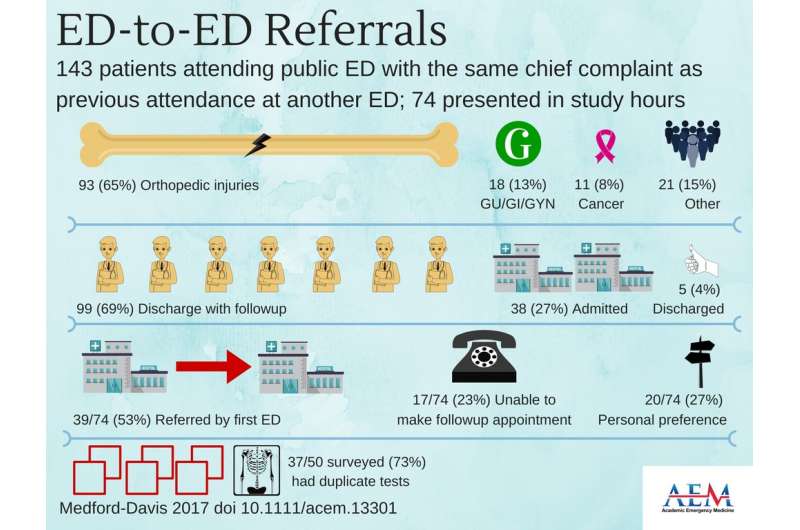Referrals by private ERs are prevalent in communities with a public hospital

The practice of indirect referrals by nonpublic emergency departments and their affiliated physicians are prevalent in communities with a public hospital option. Uninsured patients are the most affected. Those are the primary findings of a study to be published in the January 2018 issue of Academic Emergency Medicine (AEM), a journal of the Society for Academic Emergency Medicine (SAEM).
The lead author of the study is Laura N. Medford-Davis, MD, MS, an assistant professor of emergency medicine at Baylor College of Medicine, and a healthcare consultant. Dr. Medford-Davis has worked for the Center for Medicare and Medicaid Innovation, the World Health Organization, Indian Health Services, and the National Institutes of Health. Her published research focuses on improving value in health care delivery through care coordination, and access to care for vulnerable populations.
The study by Medford-Davis, et al, found that the majority of patients presenting to a public hospital emergency department after treatment for the same complaint in another local emergency department were indirectly referred to the public emergency department without transferring paperwork or records, incurring duplicate testing and patient anxiety.
The study went on to suggest that duplicate visits and diagnostic testing incur additional costs for both the patient and the public and can place unnecessary resource strain on the public hospital, in addition to increasing radiation exposure to patients.
The findings support the need to increase transparency and align incentives so that efficient, cost-effective, high-quality, definitive patient-centered care can be provided for all patients.
Some view the practices of for-profit hospitals as inhumane, as expressed by one patient participant: "Like awful, man. Awful like a piece of trash, because if you don't have the money or health insurance you ain't worth nothing."
Harrison Alter, MD, MS, FACEP, Associate Chair for Research in the Department of Emergency Medicine at Highland Hospital and Executive Director of the Andrew Levitt Center for Social Emergency Medicine commented:
"This paper elegantly illustrates the extent that private hospitals will go to avoid caring for patients whom they believe won't benefit their bottom line. These hospitals and their doctors have carved out a precise set of loopholes and workarounds to important patient-protection laws dating back 30 years. Laws like EMTALA are meant to assure that patients get the care they need no matter their economic situation, or what ER they show up in. Dr. Medford Davis and her colleagues show that flouting these laws results in duplication and waste, unnecessary radiation exposure, and on occasion, unwarranted and indefensible risk to patients."
More information: Laura N. Medford-Davis et al, "What Do People Do If They Don't Have Insurance?": ED-to-ED Referrals, Academic Emergency Medicine (2017). DOI: 10.1111/acem.13301
















